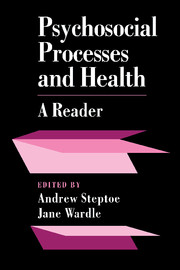Book contents
- Frontmatter
- Contents
- Preface
- Section 1 Life stress, social support and health
- Section 2 Psychophysiological processes in disease
- Section 3 Personality, behaviour patterns and health
- Section 4 Health practices and the modification of health risk behaviour
- Section 5 Coping with illness and disability
- Section 6 Behavioural interventions in medicine
- Randomised controlled trial of nicotine chewing-gum
- Conditioned side effects induced by cancer chemotherapy: prevention through behavioral treatment
- Improvement of medication compliance in uncontrolled hypertension
- Effect of psychosocial treatment on survival of patients with metastatic breast cancer
- Alteration of type A behavior and its effect on cardiac recurrences in post myocardial infarction patients: summary results of the recurrent coronary prevention project
- Can lifestyle changes reverse coronary heart disease? The Lifestyle Heart Trial
- Index
Conditioned side effects induced by cancer chemotherapy: prevention through behavioral treatment
from Section 6 - Behavioural interventions in medicine
Published online by Cambridge University Press: 05 August 2016
- Frontmatter
- Contents
- Preface
- Section 1 Life stress, social support and health
- Section 2 Psychophysiological processes in disease
- Section 3 Personality, behaviour patterns and health
- Section 4 Health practices and the modification of health risk behaviour
- Section 5 Coping with illness and disability
- Section 6 Behavioural interventions in medicine
- Randomised controlled trial of nicotine chewing-gum
- Conditioned side effects induced by cancer chemotherapy: prevention through behavioral treatment
- Improvement of medication compliance in uncontrolled hypertension
- Effect of psychosocial treatment on survival of patients with metastatic breast cancer
- Alteration of type A behavior and its effect on cardiac recurrences in post myocardial infarction patients: summary results of the recurrent coronary prevention project
- Can lifestyle changes reverse coronary heart disease? The Lifestyle Heart Trial
- Index
Summary
Abstract
Cancer patients receiving chemotherapy often experience nausea and vomiting that develop as a result of classical conditioning. In order to determine whether this nausea and vomiting could be delayed or prevented, 24 cancer patients were randomized either to a group that received progressive muscle relaxation training (PMRT) plus guided imagery (GI), or to a no-treatment control group. Relaxation training sessions were held before the initiation of chemotherapy and during the first three chemotherapy treatments. Results indicated that patients receiving PMRT and GI had significantly less nausea and vomiting and significantly lower blood pressures, pulse rates, and dysphoria, especially anxiety, than did control patients. Nurse observations corroborated patient reports. These data suggest that early training in PMRT and GI can reduce and perhaps prevent the development of conditioned nausea and vomiting, and can alleviate high anxiety levels, in cancer patients who receive emetogenic chemotherapy.
The side effects of cancer chemotherapy can be so aversive and debilitating that some patients regard them as worse than the cancer itself. Such patients often are noncompliant with their treatment, and a few reject further treatment altogether (Wilcox, Fetting, Nettesheim, & Abeloff, 1982). Among the most dreaded of the side effects are the conditioned nausea and vomiting (CNV) experienced by approximately 25%-30% of all patients. Evidence suggests that CNV develop through a classical conditioning process; that is, through their association with pharmacologically induced side effects, various stimuli (e.g., smells, thoughts, tastes) become capable of eliciting nausea, vomiting, and intense emotional reactions (see Burish & Carey, 1986). Conditioned side effects can occur before the chemotherapy treatment begins, in which case they are referred to as anticipatory side effects, or they can occur during or after the treatment, in which case they appear with and are often indistinguishable from pharmacologically induced side effects. In all cases, once CNV have developed, they are highly resistant to antiemetic drugs.
The prevalence of CNV, as well as their resistance to pharmacological control, has produced considerable concern and research in recent years. Several investigators have studied the effectiveness of behavioral treatments such as progressive muscle relaxation training (e.g., Lyles, Burish, Krozely, & Oldham, 1982), systematic desensitization (e.g., Morrow & Morrell, 1982), biofeedback (e.g., Burish, Shartner, & Lyles, 1981), and hypnosis (e.g., Redd, Andresen, & Minagawa, 1982) in controlling conditioned side effects.
- Type
- Chapter
- Information
- Psychosocial Processes and HealthA Reader, pp. 439 - 456Publisher: Cambridge University PressPrint publication year: 1994

